Authentic Hungarian Goulash (Gulyás)
This post may contain affiliate links. See my disclosure policy.
A thoroughly authentic Hungarian Goulash recipe with a depth and richness of flavor that will satisfy both body and soul. Hungary’s national dish, this traditional gulyás captures everything that has made this dish so beloved across the globe. It is simply out-of-this-world delicious!
For more traditional Hungarian recipes be sure to also try my Chicken Paprikash, Bean Goulash, Pörkolt, and Szegedin Goulash!

Traditional Hungarian goulash is a prime example of how a few simple ingredients, cooked properly, can yield an incredible flavor. Though many variations of Hungarian goulash exist, and every cook makes it just a bit differently, this is an authentic recipe from the heart of Hungary.
Hungary holds a special place in my heart and in my family’s hearts. My brother lived there for a couple of years and would always describe its beautiful scenery and architecture and his love for the Hungarian people. When I visited Budapest for the first time I immediately fell in love with it. Its name comes from the two sides of the city (Buda and Pest) separated by the Danube River running through it. With its striking chain bridge, stunning parliament building, and its incredible Buda Castle, Budapest is a breathtaking city.


Hungary’s history has been one of hardship and heartbreak. But the passion and stamina of soul has remained in the hearts of the Hungarian people. I’ve always been touched by Hungary’s national anthem, Himnusz, or “hymn”, written by the poet Kölcsey. Their anthem is a poetic prayer and unlike most anthems that focus on an expression of national pride, the Hungarian anthem is a direct, heartfelt plea to God. In the mid-20th century, during the years of strongest communist rule in Hungary, the words were not sung, only the music was played. The communist government asked two of the most acclaimed artists of that time, a poet and composer, to rewrite the national anthem. Both refused. The next communist leader also tried, unsuccessfully, to have it changed. And so Hungary’s national anthem remains Himnusz and its first three lines read:
O God, bless the nation of Hungary
With your grace and bounty
Extend over it your guarding arm

I also love Hungarian food. Their breads and smoked sausages are fantastic as are their meats, stews, sauces, and desserts. Today I’m going to share the national dish of Hungary: Goulash.
What is Hungarian Goulash?
Contrary to popular belief here in the U.S., Hungarian goulash is NOT made with ground beef or macaroni noodles! Traditional Hungarian goulash is an entirely different dish.
Goulash, or as Hungarians call it, gulyás, means “herdsman.” Its origins date back to the 9th century Magyar shepherds as a simple meat and onion stew prepared in heavy iron kettles known as bogracs. In the 15th century invading Ottoman Turks introduced a new spice to Hungary, paprika. While the rest of Europe remained lukewarm towards this red chili pepper from the New World, Hungary embraced it and paprika has since become a defining element of Hungarian cuisine.
Goulash is kind of in between a soup and a stew. Unlike some stews, Goulash is not overly packed full of beef and vegetables, it is a little more brothy. But through the cooking process, the broth becomes a little thicker and very rich in flavor.
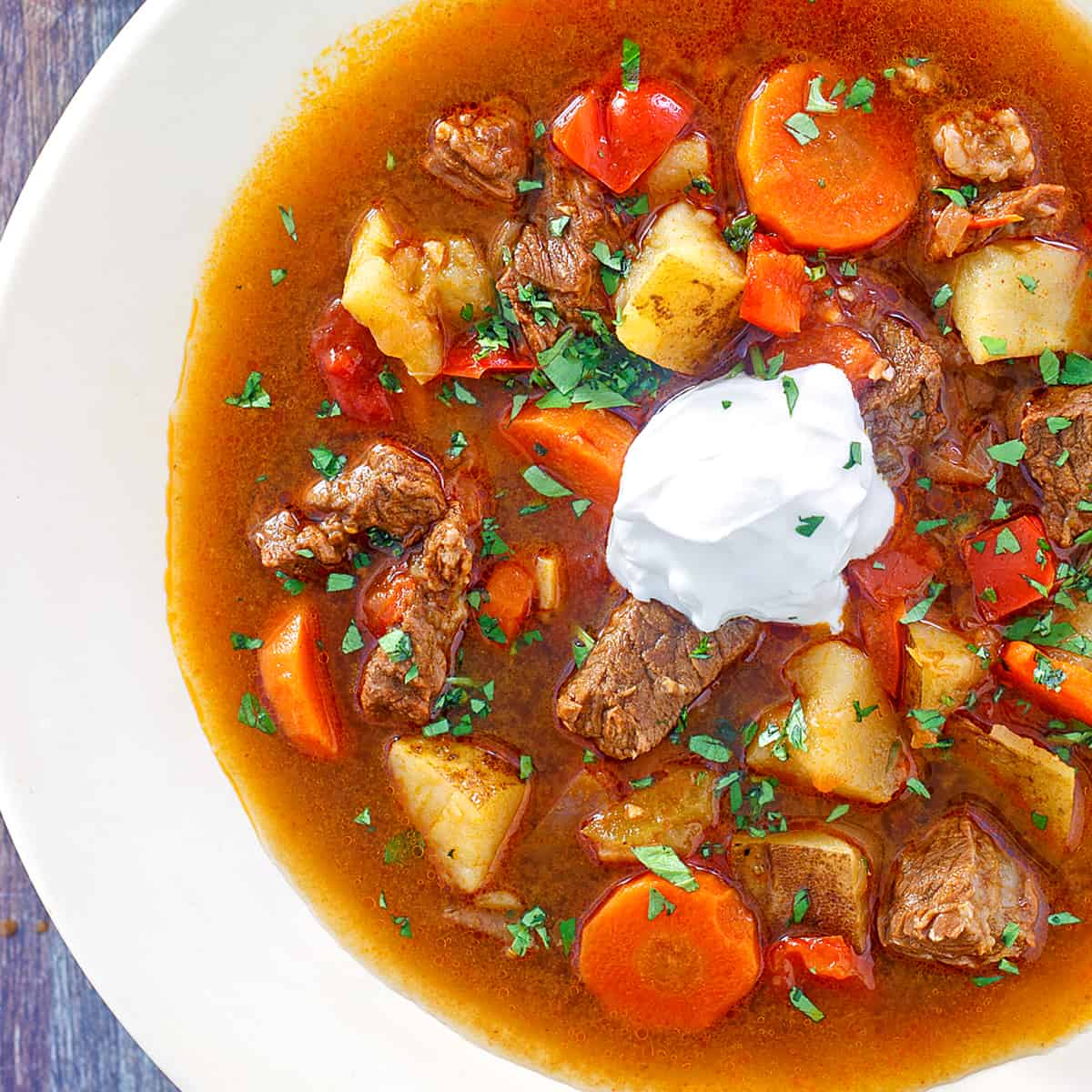
Tips for Authentic Hungarian Goulash
To achieve the ultimate flavor, the cooking method is important and quality, real Hungarian paprika is essential. And lots of it! None of this “2 teaspoons of paprika” jazz. Hungarians use very generous amounts of paprika, and that’s key. A Hungarian once told me, “however much paprika the recipe calls for – at least double or triple it!”
For this size batch of Goulash, you want to use a full 1/4 cup of it. When I lived in Germany, Hungary was just a few hours away and I would stock up on it when I visited. Now I order it online and recommend this genuine imported Hungarian paprika imported from Hungary. There is no comparison in flavor. It has an extraordinarily rich flavor and an exceptionally vibrant red color. Many of our readers have tried it and agree that quality Hungarian-imported paprika makes all the difference.

I mentioned earlier, many variations of goulash exist. Some include turnip or wine or caraway seeds, to name a few. But this recipe is a very old, very traditional way of making Goulash that my brother and I learned from older generations of Hungarian women and it needs no embellishments. It’s simple and simply delicious!
What’s the Best Dutch Oven to Use?
For this recipe, I recommend using a Dutch oven because it seals in the flavors and heats evenly, ensuring consistent cooking results. I love this 6-quart, budget-friendly option from Lodge, which you can get on Amazon for around $80. Or, if you’re looking for a worthy splurge, I also have this one from Le Creuset, which sells for around $300.
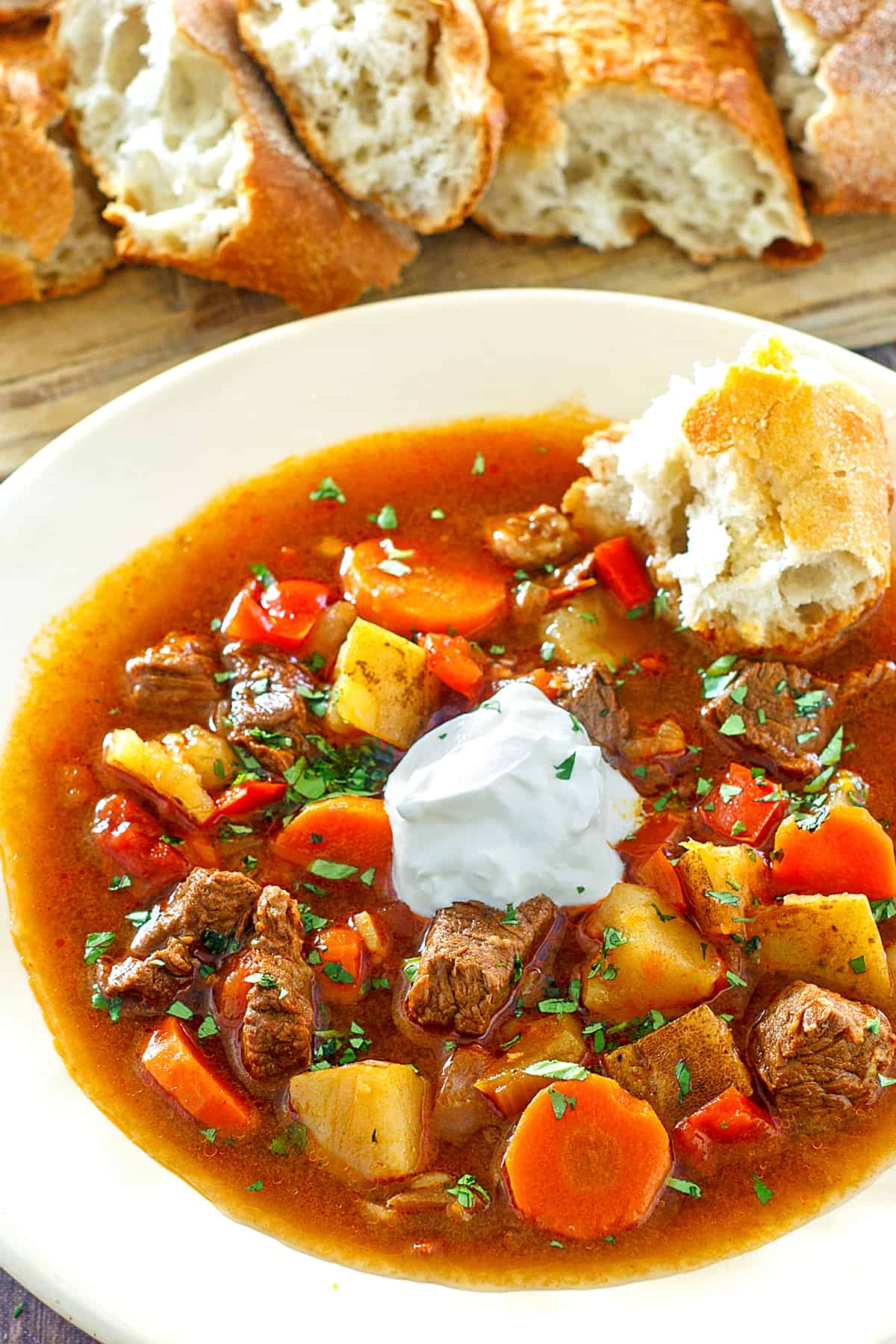
Hungarian Goulash Recipe
Let’s get started!
Melt the lard or butter/oil in a Dutch oven or other heavy soup pot over medium high heat and cook the onions until beginning to brown, about 7-10 minutes. Add the beef and cook until the beef is just starting to brown, 7-10 minutes.
Add the bell peppers, tomatoes, and garlic and cook for another 6-8 minutes. (Note about peppers: Outside of Hungary it’s very difficult to find the peppers they use there. The best ones to use in their place are red and some yellow/orange. Avoid regular green bell peppers as they have a starkly different flavor profile.)
Remove the pot from the heat and stir in the paprika, salt, pepper and caraway (if using) (note: paprika becomes bitter if at all scorched).
Add the beef broth, bay leaf, return to the stove and bring to a boil. Reduce the heat to medium, cover and simmer for 40 minutes. Add the carrots and potatoes. Return to a boil, reduce the heat to medium, cover, and simmer for another 30-40 minutes or until the beef is nice and tender. Add salt to taste. Remove the bay leaf.
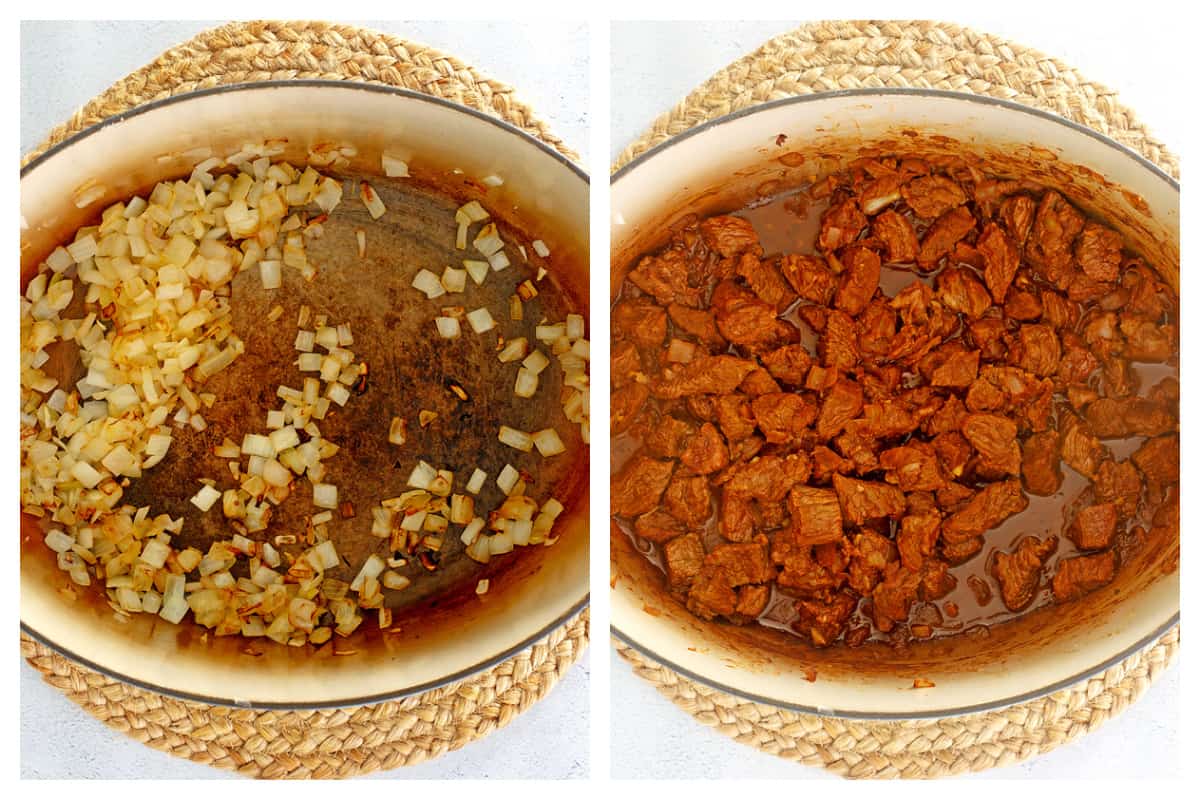

Serve with some crusty bread and, if desired, a dollop of sour cream.
Enjoy!

For more authentic Hungarian dishes, be sure to try my:
Save This Recipe
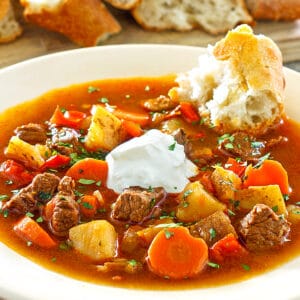
Authentic Hungarian Goulash (Gulyás)
Ingredients
- 3 tablespoons pork lard , or butter or bacon grease (pork lard is traditionally used and imparts a great flavor)
- 1 1/2 pounds yellow onions chopped
- 1/4 cup quality genuine imported Hungarian sweet paprika
- 1 1/2 pounds stewing beef , cut into 1/2 inch pieces
- 5 cloves garlic ,minced
- 2 red bell peppers ,seeded/membranes removed, cut into 1/2 inch chunks
- 1 yellow bell pepper ,seeded/membranes removed, cut into 1/2 inch chunks
- 2 tomatoes ,diced
- 2 carrots ,diced
- 2 medium potatoes ,cut into 1/2 inch chunks
- 5 cups beef broth (traditionally just water is used but beef broth adds so much more flavor)
- 1 bay leaf
- 1 teaspoon salt
- 1/2 teaspoon freshly ground black pepper
- 1/2 teaspoon crushed caraway seeds (optional, not traditional in all regions)
Instructions
- Melt the pork lard or butter/oil in a Dutch oven or other heavy soup pot over medium high heat and cook the onions until beginning to brown, about 7-10 minutes. Add the beef and cook until the beef is just starting to brown, 7-10 minutes. Add the bell peppers, tomatoes, and garlic and cook for another 6-8 minutes. Remove the pot from the heat and stir in the paprika, salt, pepper and caraway (if using) (note: paprika becomes bitter if at all scorched). Add the beef broth, bay leaf, return to the stove and bring to a boil. Reduce the heat to medium, cover and simmer for 40 minutes. Add the carrots and potatoes. Return to a boil, reduce the heat to medium, cover, and simmer for another 30-40 minutes or until the beef is nice and tender. Add salt to taste. Remove the bay leaf.
Nutrition
Originally published on The Daring Gourmet on March 18, 2014



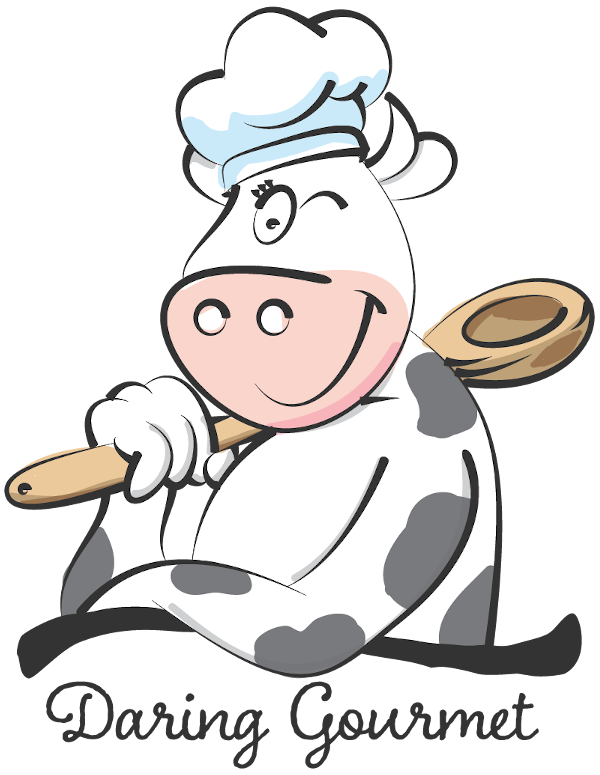
















This was excellent. It will be my go-to beef stew recipe since it is so much more flavorful than regular beef stew. It would be easy to swap vegetables as needed.
Wonderful, Shana, I’m so glad you enjoyed it, thank you!
This is great everyone. I use veal or beef shoulder cut the meat neatly and include the bones while stewing. Bones provide flavour and a source of collagen.
Thank you for your presentation of this classic dish and your kind words about Hungary and Hungarian cuisine. As we like to say, “ahány konyha annyi szokás,” or “as many traditions as kitchens.” However, if I had one quibble, I would try to disabuse English language speakers from thinking of gulyás as stew or anything resembling a stew.
As the Hungarian “Gourmet Master Cookbook” (Magyar Elek, 1932) puts it, “…certainly a respectable Hungarian food, belonging to the soup category (though also an appetizer), that is so well known in and of itself that it’s unnecessary to call it gulyás soup.”
I braise the meat, onions, peppers and (optionally) tomato first in just enough liquid to develop a rich gravy until the meat is almost tender enough. I believe braising in short liquid is one of the keys to a rich broth later. Then, I fill it with enough water (or stock) to make it a soup; adding the potatoes (and optionally carrots) and cooking until done. I add parsley too, not bay leaves.
I have a growing interest in Hungarian food history and if you’re interested, I translated the entire recipe from the aforementioned cookbook. You’ll have my email. It’s a hoot to read because it’s very descriptive. Of course, it’s not the sole authoritative source; but it is a well known book.
I made this last night with red, orange, and yellow peppers using red onions and regular paprika because I did not have the Hungarian one (but will probably buy it later). It was delicious. The meat was tender as noted, the potatoes had the right consistency (not too soft or hard). I used 3 large russet potatoes instead of two medium. Note when it says to simmer first for 40 minutes then another 30-40 minutes when you add the potatoes, carrots, and tomato. I did 40 minutes extra because I had added 3 large potatoes cut up as directed. The broth was flavorsome, but I would add 2 lbs. of meat if you go with 3 large potatoes. Also, added extra carrots. The broth, I kept to what was required. This is a great recipe and will keep it in my recipe box. Thank you for making this available for others to enjoy.
Thanks so much for the feedback, Rosie, I’m happy you enjoyed it!
Where is the note about what beef to use?
Hi Lydia, use stewing beef (ie, either chuck or round).
As a Hungarian, I would suggest shank.
If we could Only afford even Chuck steak,,,oxtail,,
for years and years has become a meat only the rich can afford.. from western Canada
I am always looking for a genuine Gulash recipe and will follow yours.. However I was told by some migrant Hungarians to Oz that lamb is what the herders used when making Gulash (Guylas)….:)
what say you?
Thanks for your good work in preparing this display…
Hi Claire! No, the Hungarian herdsman were specifically cattle herders. They were known since the Middle Ages for herding massive numbers of cattle on the Puszta (Great Hungarian Plain) and supplied cattle/beef to a number of other European countries. In their preparation of goulash they were known for using every part of the cow. I’ve never seen goulash made with lamb, not in Hungary at least. Lamb is mostly eaten on special occasions there.
Made this love it! I did half beef broth half chicken for personal preference. But its super good! Also I appreciate the extra notes on cutting the veges in the recipe. Thank you
Great recipe. But – I made a couple of changes. First, I used bacon grease – cooked 3 pieces of bacon – ate them and used the grease. Then I mixed 5 tablespoons of Better than Bouillon Beef Base (has no MSG) with 5 cups of water. I left out the caraway seeds as I had a nasty mess happen with them years ago and totally ruined a dish. Also – I did not cook this on the stove but in my Power Pro XL Pressure Cooker on the Stew icon. Did all of the sauteing that was recommended, put it under high pressure for 15 minutes, did a natural release for 10 minutes. It came out super tender. Of course I used the dollup of sour cream and served it with crusty French Bread and a green salad. Yum!!!!! Thanks for sharing this recipe. Will make it again.
Awesome, Kathi, I’m glad you enjoyed it and thanks for the pressure cooker info!
I am just checking to make sure it is not a typo – 5 tablespoons of Better that Bouillon to 5 cups of water?
I haven’t made this, but it sounds so good, and I often read through some of the comments before making a new recipe, which prompted me to double check with you.